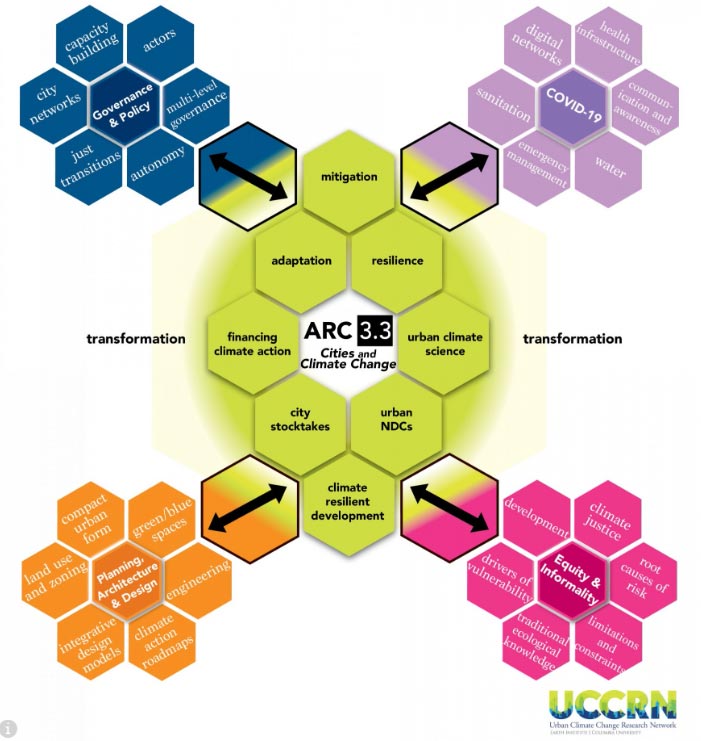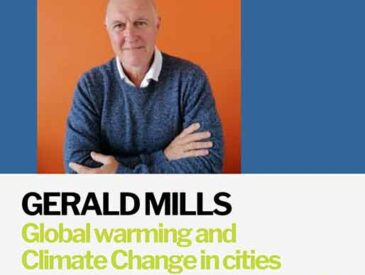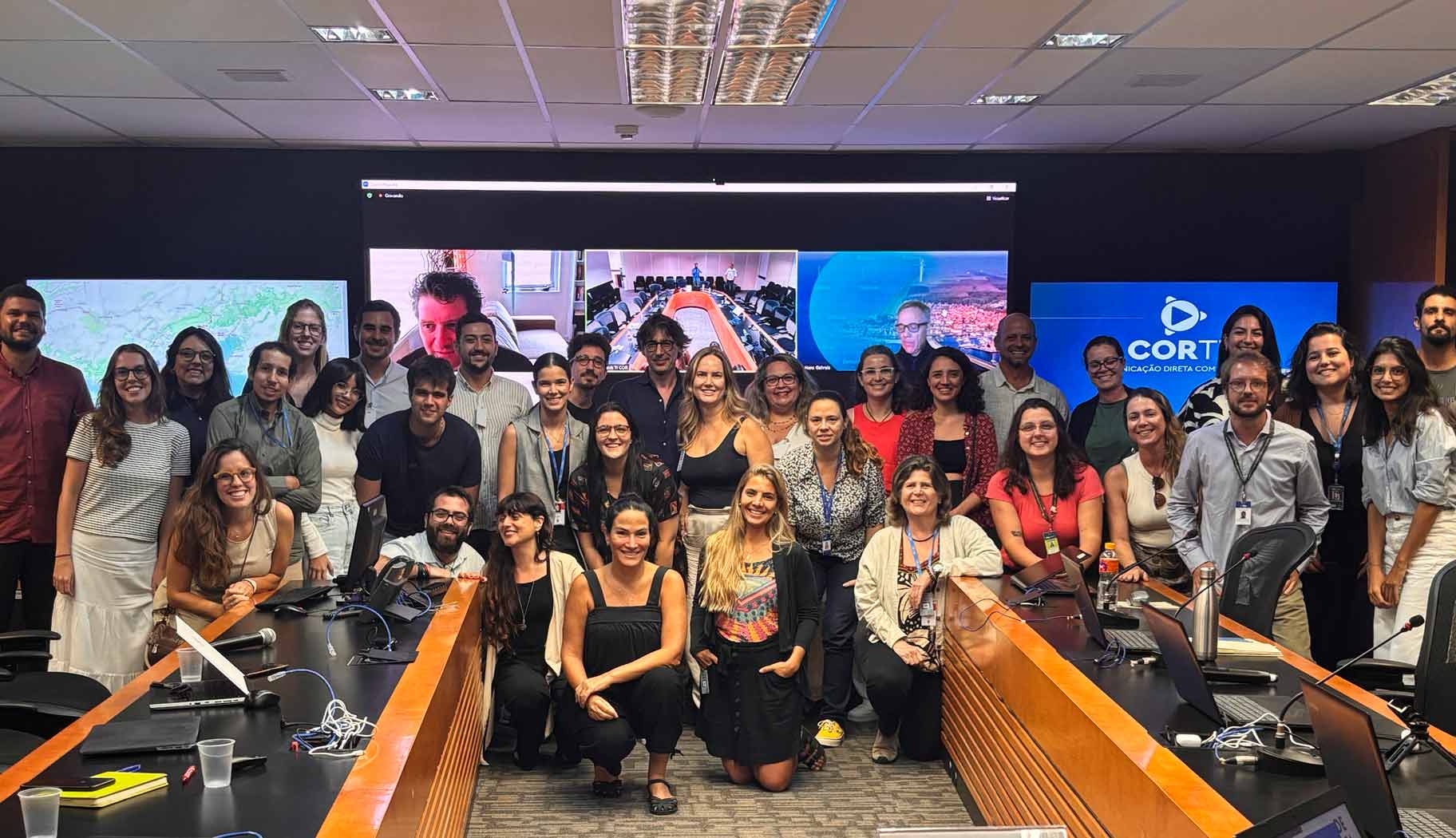List of Contents
Key concepts
- Mitigation strategies
- Climate Preparedness
- Response
- Post Disaster Recovery and Rebuilding
- Sendai Framework & “New Ten Essential”
- Risk Reduction and adaptation
- References
Urban centers worldwide are confronting the escalating impacts of climate change. Recent assessment reports note that it is very likely that heat waves will occur more often and last longer and that extreme precipitation events will become more intense and frequent. The rise of the global mean sea level will increase the risks to coastal systems and low-lying areas.
The disaster risk cycle in cities refers to the phases that urban areas go through in relation to the potential occurrence and management of disasters. These phases typically include mitigation strategies, preparedness, response, recovery and adaptation. Moreover, since past events can only partially inform decision-makers about emerging and increasing climate risks, risk assessments must incorporate knowledge about both current climate conditions and future projections.
Mitigation strategies
Responses to climate change in cities consist of the design and implementation of policies and practices to reduce anthropogenic GHG emissions, known as mitigation measures. For mitigation planning, the primary goal is to reduce current and future direct and indirect GHG emissions, particularly from energy production, land use, waste, industry, the built environment infrastructure, and transportation.
Climate Preparedness
Climate preparedness refers to the actions taken by individuals, communities, governments, and organizations to anticipate, adapt to, and mitigate the impacts of climate change. For example, the latest disaster caused by Super Typhoon Haiyan in 2013 in the Philippines led to around 6,000 fatalities and more than 27,000 injured with thousands missing. The small city of Tacloban was among the areas that sustained significant damage and losses as a result of the Super Typhoon Haiyan. Prior to the disaster, the Philippine government developed the Climate Change Act of 2009, creating the Climate Change Commission, the National Strategic Framework on Climate Change and the National Climate Change Action Plan to guide the mainstreaming of climate change adaptation in policy and planning. It enacted the Philippine Disaster Risk Reduction and Management Act of 2010 to guide disaster risk reduction actions in the Philippines. It also established the People’s Survival Fund as a long-term finance stream for climate change actions.

Discover ARC3.3
UCCRN edu is proud of its active participation in the development and dissemination of innovative content for ARC3.3, a publication by Cambridge University Press. Discover the new ARC3.3 release!
Response
The effects of climate-related disasters can be amplified in cities because of how they interact with urban infrastructure systems, growing urban populations, cultures, and economic activities. Because the majority of the world’s population currently lives in cities, cities need to focus on improving their responses to climate-related disasters, such as heat waves, floods, and droughts. Decision-makers need to incorporate knowledge about both current climate conditions and future projections in risk assessments because past events can only partially inform them about climate risks. A paradigm shift of this magnitude will require urban decision-makers and stakeholders to increase the institutional capacity of many communities and organizations to apply a systems lens to coordinating, strategizing and implementing risk-reduction, disaster response and recovery plans on a flexible and highly adaptive basis.
Post Disaster Recovery and Rebuilding (DRR)
Post-disaster recovery and rebuilding is a tool for disaster risk reduction and resilience building. Several researchers have demonstrated how disasters can open rare windows of opportunity for instituting long-term change. From a practitioner perspective, any recovery activity following a disaster that fails to reduce the population’s exposure to risks is merely sowing the seeds for future disasters. Consequently, DRR is becoming increasingly recognized as an integral component of successful disaster recovery policy and rebuilding programming.
Sendai Framework and “New Ten Essential”
In March 2015, representatives from 187 United Nations Member States adopted the first major agreement of the Post-2015 development agenda, the Sendai Framework for Disaster Risk Reduction. Policy-makers will now need to reassess the significance of resilience-building in cities as they implement the SFDRR. To support the implementation of SFDRR and the more than 2,500 cities in the UNISDR Making Cities Resilient program, a group of city and expert partners in urban resilience, including the UCCRN, have now proposed a set of New Ten Essentials. The proposed New Ten Essentials build on the previous Ten Essentials, are linked with the priorities for action of the SFDRR, and represent a transition to implementation. The primary objective is to be operational, adaptive, and applicable to all and encourage cities to implement disaster risk reduction (DRR).
Risk reduction and adaptation for improving resilience
Integrating climate change adaptation with disaster risk reduction involves overcoming a number of barriers. The key barriers include lack of climate resilience in a city’s development vision, limited understanding of the hazards, vulnerabilities, and resulting risks; lack of coordination between administrative and sectoral levels of city management, inadequate implementation and financial capacities and poor connection between climate adaptation and risk management efforts and cities’ development strategies. Central strategies for improving resilience and managing risks in cities include the integration of disaster risk reduction with climate change adaptation, land-use planning and innovative urban design, financial instruments and public–private partnerships, management and enhancement of ecosystem services, strong institutions and communities and effective pre- and post-disaster recovery and rebuilding.
References
Lead Authors & Contributors
- Ebru Gencer (New York/Istanbul), Regina Folorunsho (Lagos), Megan Linkin (New York), Xiaoming Wang (Melbourne), Claudia E. Natenzon (Buenos Aires), Shiraz Wajih (Gorakphur), Nivedita Mani (Gorakphur), Maricarmen Esquivel (Washington, D.C./San José), Somayya Ali Ibrahim (New York/Peshawar), Hori Tsuneki (Washington, D.C.), Ricardo Castro (Buenos Aires), Mattia Federico Leone (Naples), Dilnoor Panjwani (New York), Patricia Romero-Lankao (Boulder/Mexico City), William Solecki (New Brunswick/New York), Brenda Lin (Melbourne), Abhilash Panda (Geneva);
- Rosenzweig, C., Solecki, W., Romero-Lankao, P., Mehrotra, S., Dhakal, S., & Ali Ibrahim, S. (Eds.). (2018). Climate Change and Cities: Second Assessment Report of the Urban Climate Change Research Network. Cambridge University Press.
Mitigation Strategies
- Vignola, R., Locatelli, B., Martinez C., and Imbach, P. (2009). Ecosystem-based adaptation to climate change: What role for policy-makers, society and scientists? Mitigation and Adaptation Strategies for Global Change 14, 691–696.
- Lin, B., Khoo, Y. B., Inman, M., Wang, C. H., Tapsuwan, S., and Wang, X. (2014). Assessing inundation damage and timing of adaptation: sea level rise and the complexities of land use in coastal communities. Mitigation Adaptation Strategies Global Change 19, 551–568.
Climate Preparedness
- Philippine Statistics Authority. (2014). Leyte Province. Municipalities and cities. Accessed March 24, 2015: http://www.nscb.gov.ph/activestats/psgc/province.asp
- World Bank. (2017). 2016 GNI per capita, Atlas method (current US$). Accessed August 9, 2017: http://data.worldbank.org/indicator/NY.GNP.PCAP.CD
Response
- City of Boulder Flood Management Program (2014).City of Boulder. Accessed February8,2015: https://www-static.bouldercolorado.gov/docs/flood-management-program-overview-1–201410060951.pdf
- Peel, M. C., Finlayson, B. L., and McMahon, T. A. (2007). Updated world map of the Köppen-Geiger climate classification. Hydrology and Earth System Sciences Discussions 4(2), 462.
Post Disaster Recovery and Rebuilding (DRR)
- United Nations (UN). (2015). Sendai Framework for Disaster Risk Reduction 2015–2030. Third UN World Conference on Disaster Risk Reduction. Sendai, Japan. A/CONF.224/CRP.1. Accessed May 18, 2016: http://www.wcdrr.org/
Risk Reduction and adaptation
- Sri Lanka Red Cross Society (SLRCS). 2015. Districts and local authorities. Accessed April 11, 2016: http://www.redcross.lk/srilanka-country-profile/districts-and-local-authorities/
- Graymore, M., Wallis, A., and Richards, A. (2009). An index of regional sustainability: A GIS-based multiple criteria analysis decision support system for progressing sustainability. Ecological Complexity 6, 453–462.





